
P.D. GRIFFIN
ENCYCLOPEDIA OF MODERN BRITISH ARMY REGIMENTS
Most countries keep a special force for covert operations but the SAS is world famous for its intensive training and efficiency. From the doctrine of small units tying down entire armies to damage and demoralise the enemy, often on its own territory, came the basic four-man patrol, composed of a leader, scout, signaller and medic. Stirling devised small operational patrols in the desert on the premise that they would be less noticeable than a large assault force. The regiment was the first to perfect the technique of abseiling from helicopters as a rapid-drop manoeuvre.
Officers and troopers work together to the highest standards, imbued with self- discipline, often disguised as natives of the region in which they operate. Individual identities and achievements are never publicly aired or celebrated.

THE SPECIAL RECONNAISSANCE REGIMENT
The Special Reconnaissance Regiment (SRR) was formed in 2005 as part of the special forces group for covert surveillance work in support of international expeditionary operations in the fight against terrorism.
A beige beret was adopted on formation, as worn in the SAS. The cap badge is an ancient Corinthian helmet on a special forces' upright dagger with a scroll labelled 'Reconnaissance'. The helmet, with its dark eve-holes, symbolises the unseen watcher. MUSIC
The official march of the Reconnaissance Corps formed in the Second World War was Away to the Mountain's Brow.
The Reconnaissance Corps born in 1941 was employed to scout ahead of army divisions to determine enemy strength and movements, a hazardous task that required men with good survival skills.
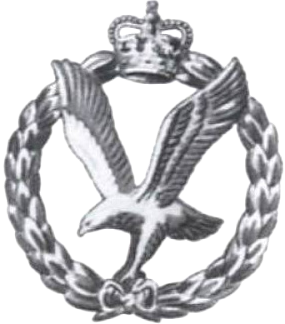
The Army Air Corps (AAC) was formed in 1957 out of the Royal Artillery's Observation Post squadrons and the light liaison flights of the Glider Pilot Regiment, both created in 1942. The corps employs six regiments, five independent squadrons and various flights stationed around the globe to give helicopter support to land forces and an air assault capacity in battle. Corps headquarters and the School of Army Aviation are located at Middle Wallop in Hampshire. DRESS DISTINCTIONS
A Cambridge blue beret is worn by all ranks, the badge pinned to a square patch of dark blue. The corps badge, a restyling of the eagle badge of the Glider Pilot Regiment, shows an eagle landing, contained within a crowned wreath.
The eagle alighting without the crown and wreath is worn on collars, buttons and on sergeants' sleeves above the chevrons.
No. 1 dress 'blues' are identified by the beret, Cambridge blue piping on the shoulder straps, and a broad scarlet stripe on the trousers like that worn by the Royal Artillery, which helped form the AAC, and the Royal Engineers, who pioneered army flying. Bandsmen wear a full dress blue tunic which is fashioned with a double- breasted plastron in the style of jackets of the Royal Flying Corps from 1912 to 1918.

AAC soldiers grounding arms in front of a Lynx. (MoD)
The corps quick march is Recce Flight, the slow march, Thievish Magpie, a martial reworking of Rossini's opera score of 1817.
In the 1950s and 60s, pilots of the AAC were supported by ground crew supplied by the Royal Armoured Corps and the Royal Artillery. It wasn't until 1973 that the corps recruited its own air troopers, who, after promotion to corporal, may apply for pilot training; two-thirds of army pilots are noncommissioned officers.
The 2nd Regiment AAC is responsible for ground-crew training, which involves base protection, ground-to-aircraft communications, arming and fuelling.
Candidates for pilot training have to pass RAF selection tests and army flying grading on fixed-wing aircraft before ground school, which deals with basic principles of flight, meteorology, navigation, and aeromedical and survival training. After nine weeks at the Defence Helicopter Flying School, trainee pilots go for operational training at the School of Army Aviation for eighteen weeks before converting to type. Helicopter types range from the general purpose Gazelle to the anti-tank Lynx and the sophisticated Apache attack.

Officers' mess dinner night at Middle Wallop. Uniforms without Cambridge blue facings are guests from other corps. (MoD)
Helicopters' traditional use, in observation, troop lifts and casualty evacuation, now extends to aerial command posts, fire support and missile strikes on heavy targets. Their extensive use in the army has transformed the way it operates in all situations and the AAC may now be recognised as the new combat arm.

The regimental padre heads a service for three Staffords killed in Iraq, 2005
The corps' cavalry-style guidons are emblazoned with the badges of the Royal Artillery and the Glider Pilot Regiment, with battle honours for the Falkland Islands and the Gulf conflicts.
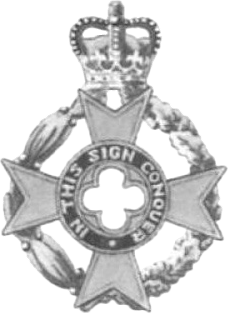
THE ROYAL ARMY CHAPLAINS' DEPARTMENT
An Army Chaplains' Department was set up in 1796 after an expedition to the West Indies had to leave without a single cleric on board to look after the soldiers' spiritual needs. Before this sudden decline in the support of civilian clergymen, British regiments had always sailed with a chaplain in the ranks. Presbyterian ministers were admitted to the department in 1827, followed by Roman Catholic in 1836, Wesleyan in 1881 and Jewish in 1892.
The 'Padres' lost 172 officers helping soldiers in the trenches during the First World War, and in 1919 the department was granted its Royal title.
The blue peaked cap is distinguished by a purple band and the RAChD badge, a Maltese cross on a crowned laurel and oak wreath with, in the centre, a voided quatrefoil with a circle inscribed IN THIS SIGN CONQUER, the exclamation of the Emperor Constantine who converted to Christianity after seeing a cross in the sky. Jewish chaplains wear a Star of David in place of the Maltese cross and no motto.
In service dress a white clerical collar is worn instead of shirt, and a black leather pouch belt with the badge is worn over the jacket. Buttons and rank pips are black. The blue mess dress has purple facings.
The RAChD march is Jeremiah Clark's Trumpet Voluntary or the Prince of Denmark's March, which is thought to have been written after he was appointed organist at St Paul's Cathedral in 1699.
Chaplains are appointed by the Parliamentary Under Secretary of State for the Armed Forces on the nomination of the named faiths. All members of the RAChD are commissioned officers ranked, since 1858, to a system where a Chaplain of the 1st Class is equal to Colonel, of the 2nd Class to Lieutenant Colonel, 3rd Class to Major and 4th Class to Captain. The senior officer is the Chaplain General.
These officers hold a unique position of approachability between the troubled soldier and the chain of command. On home stations padres give pastoral care and welfare to serving soldiers and their families. On active service they bring help and comfort to the wounded and the grieving, an essential support service to an army at war.
The Gurkha Brigade is exceptional and relies on its regimental pandits.
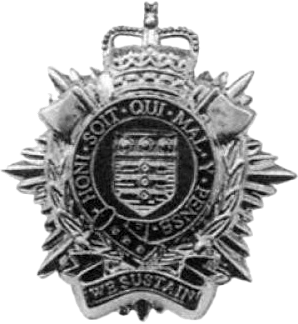
The Royal Logistic Corps (RLC) was formed in 1993 by the amalgamation of four support corps, and elements of another, that kept the army moving, supplied, fed and operational. Put together their workload created a huge organisation that now embraces the largest single storage and haulage system in the country, a shipping line and a global post network. The title comes from the French logistique, which is 'the art of moving, lodging and supplying troops and equipment'.

Ammunition wagon team struggling through a lunar landscape of the First World War
Providing for armies has long been a problem, and many kings and nobles of history have been financially crippled in the attempt. In the early part of the fifteenth century taxes were raised for a royal ordinance issued for the procurement and keeping of 'warlike stores'. The Office of Ordnance, formed in 1414 and named after this ordinance, was superseded in 1683 by the Board of Ordnance, which supplied arms and ammunition to the army and navy, built barracks and dockyards, and provided all stores to the services. A commissariat was formed to counter the problem of soldiers living off the land by dealing with their pay, victuals, forage and quartering. The Barrack Department of the eighteenth century administered and furnished living quarters. In 1794 the Commissary General recommended that the inefficient baggage trains, with their hired wagoners, animals and sutlers, be replaced with a wagon train manned by soldiers under the discipline of their officers. The Royal Waggoners served throughout the Napoleonic Wars but succumbed to the long peace of the 1830s. The inadequacies of many army services were brought sharply into public focus through reports from the Crimean War, and in 1855 a Land Transport Corps (LTC) was instituted to alleviate the soldiers' suffering. The Board of Ordnance was dissolved in the same year.

A royal visit to 20 Squadron Royal Corps of Transport, keepers of the Queen's baggage train. (Institution of the RASC and RCT)
After the Crimean War a permanent road transport regiment was created to support the army at home, on campaign and in barren lands. This Military Train absorbed the LTC, ranked as a cavalry regiment, and gained three battle honours in India and China. At this time transport, supply and stores were run by departments (officers) and worked by corps (other ranks). The Engineers, Artillery, and the Commissariat and Transport Corps relied on horse-drawn wagons, but the Royal Engineers were developing other forms of moving troops and materiel, notably by railways and canals. Their mechanical transport section was handed over to the Army Service Corps in 1902 in the shape of steam traction, and horse transport began its long phasing-out process.
In 1870 the Military Train was joined by the Stores Corps and Commissariat Corps to become a supply and transport organisation, but ten years on the stores companies were detached to pursue a separate career, providing vital supplies and armaments for an army that expanded with each great war.
The two global wars made unbelievable demands on the corps and saw the birth of the Pioneer Corps and the Army Catering Corps. The support of these five corps was as indispensable to the army then as the Loggies' are now.
RLC headquarters and training centre are at the Princess Royal Barracks at Deepcut in Surrey, the former base of the RAOC. The TA depot and training centre is at the Prince William of Gloucester Barracks in Grantham. The School of Catering is located at Aldershot, the ancestral home of the RASC/RCT. The School of Transport is at Leconfield in East Yorkshire and the School of Petroleum is in Dorset.

Pioneers securing trackway for wheeled-vehicle access to a beach; 17 Port and Maritime Regiment RLC off-loading various vehicles and equipment from a Royal Fleet auxiliary ship, using landing craft and motorised rafts. (MoD)
Blue caps and berets are graced with the crowned star of the Royal Army Service Corps (RASC) and the Royal Corps of Transport (RCT). On the star's laurel wreath lie two crossed axes from the badge of the Royal Pioneer Corps, and a Garter belt that encloses the shield of the Board of Ordnance, from the Royal Army Ordnance Corps (RAOC). Across the lower point of the star is a scroll with the Army Catering Corps' 1973 motto, We Sustain.
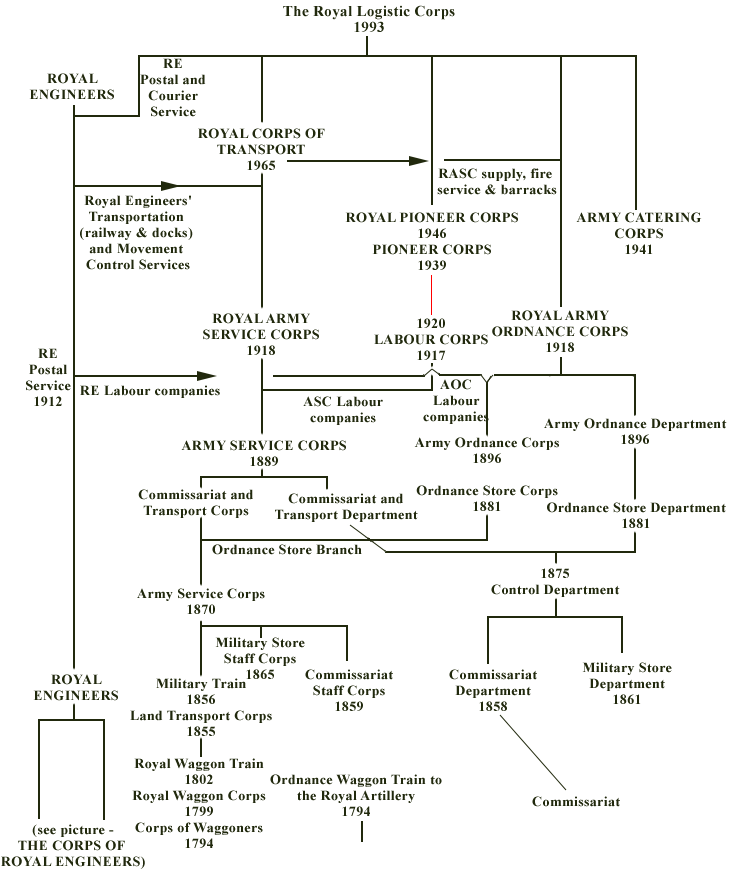
Service dress is worn with the cap by officers, the beret by other ranks and the RCT yellow/blue lanyard by all.
The blue overalls and trousers worn with No. 1 dress, mess dress and full dress are fashioned with the double scarlet seam stripe once seen in the RAOC. Otherwise these orders of dress are entirely blue, the uniform colour of both the ASC and the AOC before the general use of khaki in the early twentieth century.

Army Catering Corps chef, c. 1985
Musicians' full dress uniform incorporates the Victorian helmet fitted with the ball top favoured by the ASC for safety when working near horses. The blue tunic has scarlet edging down the front in line with the buttons, which invoke this period with a design based on buttons worn by the Commissariat and Transport Staff and the Ordnance Store Department - the royal crest within a belt.
Working dress varies greatly according to occupation. Drivers, vehicle specialists, supply specialists and controllers, pioneers and movement controllers wear uniform barrack dress or combats offset by the corps stable belt, which is blue with yellow edging and a double scarlet stripe in the middle. Chefs are issued with the white hat, jacket and apron of their calling, but marine engineers and seamen/navigators wear the blue shirt of the Royal Navy. Pilots and air dispatchers of the airmobile squadrons have a flying suit, and soldiers of the Airborne Battalion, parachute equipment.
Protective clothing is given out to petroleum operators (rubber coveralls), railwaymen and port operators (hard hat and luminous jacket), couriers (motorcycle gear) and ammunition technicians (padded explosive ordnance suit).
The corps march is Albert Elm's On Parade.
The RCT march Wait for the Wagon, an American song of 1851 based on an old English folk song, was adopted by the ASC in 1875 on a suggestion from the Commander- in-Chief, the Duke of Cambridge, at a review in Aldershot. As a march the tune was too short and in 1946 Bandmaster Dean rearranged it to include The Trek Song in homage to the many ASC companies that served in the Boer War of 1899-1902.
The Army Ordnance Corps served up to and through the First World War without a march to call its own, and in the 1920s the search was on for suitable music. The Village Blacksmith was chosen for its oblique reference to RAOC artificers' workshops, where guns and equipment were repaired and modified. As a march The Village Blacksmith had to be revised in 1941 and again in 1970.
Demuth's Pioneer Corps was adopted by that organisation in 1945. The Army Catering Corps' Sugar and Spice was an arrangement of Leveridge's Roast Beef of Old England and Dibdin's Tight Little Island.
In 1994 the RCT and RAOC bands were united to form the Band of the Royal Logistic Corps (RLC).
The 22 regular and 15 volunteer regiments of the RLC involve some 28,000 personnel, the largest of the army's corps. In battle logistic units supply and distribute ammunition, fuel, rations and spares, recover and repair damaged equipment, and treat and evacuate casualties.
Their web of responsibilities can be sourced through the corps' forerunners; the Royal Corps of Transport (Truckles'): movement of personnel, distribution of food, oil and petrol worldwide, and ammunition to units in the field by road, air, rail, water and pack animal.
The Royal Army Ordnance Corps ('Providers'): supply of food, fuel, vehicles (from cycles to tanks), guns, ammunition, equipment, spare parts, accommodation and field bakeries; the maintenance of vehicles, guns, equipment, depots and stores complexes; technical support and bomb disposal.

Air ambulance unit removing a casualty to hospital. (MoD)
The Royal Pioneer Corps ('Chunkies'): manual and mechanical materials handling; the maintenance, inspection and palletisation of fuel tanks; the loading of stores, equipment and ammunition; the defence of major headquarters with specialist dog-handling, and duties in recovering and identifying bodies prior to military/battlefield internment.
The Army Catering Corps ('Sustainers'): training and deployment of cooks to all army canteens, kitchens and field camps.

RAMC re-enactment group with an ambulance of First World War vintage
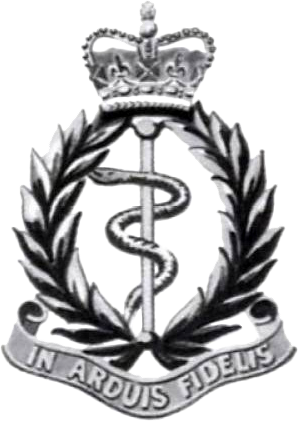
The Royal Army Medical Corps (RAMC) is descended from the Medical Staff Corps created in 1855 as a response to the poor treatment experienced by the sick and wounded in the Crimea. Prior to this soldiers in distress had to rely on the availability' of the regimental surgeon.
In 1898 the surgeon officers of the Medical Staff were united with the orderlies of the Medical Staff Corps to produce the Royal Army Medical Corps. The Army Medical School at Netley was moved to Millbank in London four years later. RAMC headquarters are now with the Army Medical Services at the former Staff College in Camberley.
The blue peaked cap is distinguished by a band and welt of dull cherry, the colour of the trim on the blue uniform of the Medical Staff Corps from the 1860s, when it went under the title of Army Hospital Corps.
The RAMC badge is a laurel wreath with a crown on top and a scroll beneath inscribed In arduis fidelis (Faithful in adversity). Inside the wreath is the international emblem of medicine, the rod of Aesculopius (the Greek/Roman god of healing) with a serpent entwined. The badge has been worn on cap and collar since the birth of the RAMC in 1898. Today it is pinned to a cherry backing when worn on the beret.
No. 1 dress 'blues' have the dull cherry on shoulder straps and the trousers stripe. In mess dress the waistcoat and the facings of the bluejacket are also of this hue.
No. 2 dress is worn with a cherry lanyard and trade bars on the sleeve. This braid was introduced in 1886 and revived in 1956 for Class I and Class II tradesmen.
Dull cherry jerseys are available for officers and warrant officers in barrack dress.
The first march of the corps was Sousa's Washington Post, but in 1914 a change was made to Her Bright Eyes Haunt Me Still, an arrangement of an 1856 composition in honour of Florence Nightingale.
In 1923 Bonnie Nell was favoured, but replaced in 1948 by a seventeenth-century air, Here's a Health unto His Majesty. Shortly after this Her Bright Eyes was reintroduced as the corps slow march.
When HM Queen Elizabeth The Queen Mother was Colonel-in-Chief, The Eriskay Love Lilt would be played on officers' guest nights.
Corps Day (23 June) was set down in 1948, on the 50th anniversary of the formation of the RAMC, being the day on which the Medical Staff joined forces with the Medical Staff Corps in 1898.
The First World War had caused a rapid expansion of army medical services to cope with the vast numbers of casualties and new types of wound. Through impossible conditions members of the RAMC struggled and adapted to support the wounded on the front line, in the regimental aid posts, the dressing stations, casualty clearing stations, base hospitals, and the hospital ships and trains.
In spite of superhuman efforts to alleviate the suffering of soldiers and civilians in all corners of the globe, the RAMC suffered an abuse of its initials, with interpretations like 'Rob All My Comrades', 'Run Away Matron's Coming', 'Radier A Mixed Crowd' and, in reverse order, 'Can't Manage A Rifle'. Rifles haven't always been carried in the corps but arms are borne today for personal protection. Medical services are subject to the Geneva Convention and although swords and bayonets are carried on parade they have to remain sheadied.
The corps continues to attend casualties and the sick in all situations, deploying field ambulance units, air ambulance, surgical teams, transfusion units, medical equipment depots, hygiene units and convalescent training depots.
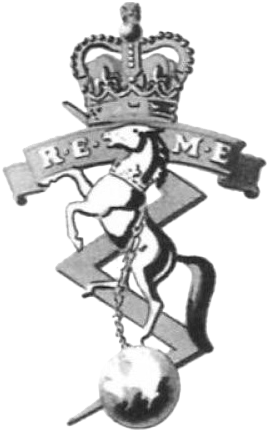
THE CORPS OF ROYAL ELECTRICAL AND MECHANICAL ENGINEERS
The Royal Electrical and Mechanical Engineers (REME) was formed in 1942 by the collation of the engineering workshops of the Royal Engineers, Royal Army Service Corps and the Royal Army Ordnance Corps, to organise and rationalise engineering support for the army's vehicles, guns and technical equipment. The corps' skills were put to the test at El Alamein, from where they grew with each development in army equipment, and now extend to eight trades and nearly 10,000 personnel.
Headquarters are located at Arborfield in Berkshire, an engineering training establishment since 1942.
We have much more interesting information on this site.
Click MENU to check it out!
∎ cartalana.com© 2009-2025 ∎ mailto: cartalana@cartalana.com